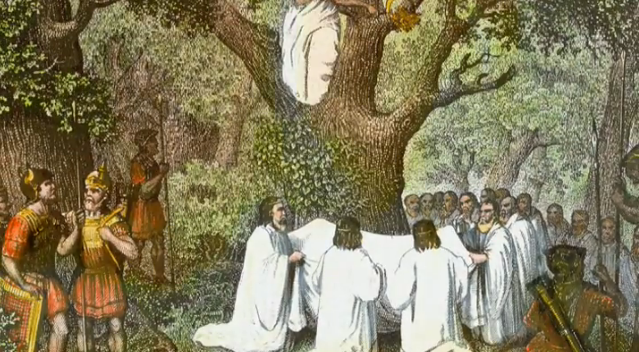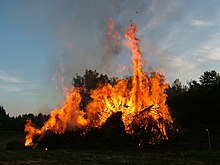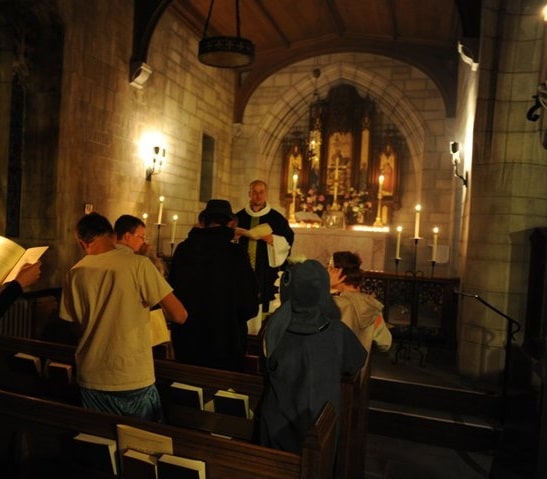Who Invented Halloween? Part 1- The History

The History of Halloween
I have had mixed feelings about blogging about Halloween.
In one sense, Halloween in the U. S. today is simply a commercialized holiday pretty devoid of the traditions, both pagan and Christian, that were at its origin many centuries ago in Europe. As such, the interest in blogging about it might be confined to today’s ways of celebrating the holiday. I could just describe them or I could critique them (doing damage, for example). All this kind of information becomes topical in the days before and just after Halloween all over the media so I don’t see the need for adding to it.
On the other hand, I could trace the history of Halloween for those in the audience who may not know it already. I suspect this may be the majority. But what would be the point? The history will show that the original customs and means of participating in them bear little resemblance to those of today. Indeed, some are quite pagan while others are intended to be quite Christian in nature. Some celebrants of today are drawn in by these early customs and meanings while others are repulsed and still many more don’t even know or care.
I guess, in the end, I just couldn’t let the topic go by so I have decided to do a history of Halloween, a commentary on the history and a wrap up of my thoughts on Halloween then and now.
So let’s get started on the history.
After searching far and wide for a good video I settled on one by History.com. It’s not all that I’d like but it’s a pretty good summary.
For the more studious post readers, I am also including some text from Wikipedia which goes into greater detail. Finally, for the most studious post readers, I am including the link to the Wikipedia article so you can get every detail!
So, here we go!
Well, any reactions yet? Want to know more? Here is the Wikipedia article PORTION I mentioned. Give it a look.
per Wikipedia
Halloween History
Gaelic and Welsh influence
The lighting of bonfires by the ancient Celts may have influenced the lighting of bonfires on All Hallows’ Eve
Today’s Halloween customs are thought to have been influenced by folk customs and beliefs from the Celtic-speaking countries, some of which have pagan roots, and others which may be rooted in Celtic Christianity.[18][19] Indeed, Jack Santino, an academic folklorist, writes that “the sacred and the religious are a fundamental context for understanding Halloween in Northern Ireland, but there as throughout Ireland an uneasy truce exists between customs and beliefs associated with Christianity and those associated with religions that were Irish before Christianity arrived.”[20] Historian Nicholas Rogers, exploring the origins of Halloween, notes that while “some folklorists have detected its origins in the Roman feast of Pomona, the goddess of fruits and seeds, or in the festival of the dead called Parentalia, it is more typically linked to the Celtic festival of Samhain“, which comes from the Old Irish for “summer’s end”.[18] Samhain (pronounced SAH-win or SOW-in) was the first and most important of the four quarter days in the medieval Gaelic calendar and was celebrated in Ireland, Scotland and the Isle of Man.[21][22] It was held on or about October 31 – November 1 and kindred festivals were held at the same time of year by the Brittonic Celts; for example Calan Gaeaf (in Wales), Kalan Gwav (in Cornwall) and Kalan Goañv (in Brittany). Samhain and Calan Gaeaf are mentioned in some of the earliest Irish and Welsh literature. The names have been used by historians to refer to Celtic Halloween customs up until the 19th century,[23] and are still the Gaelic and Welsh names for Halloween.
Samhain/Calan Gaeaf marked the end of the harvest season and the beginning of winter or the ‘darker half’ of the year.[24][25] Like Beltane/Calan Mai, it was seen as a time when the spirits or fairies (the Sí) could more easily come into our world and were particularly active.[26][27] The souls of the dead were also said to revisit their homes.[28] Feasts were had, at which the souls of dead kin were beckoned to attend and a place set at the table for them.[29] However, the spirits or fairies could also cause harm, and needed to be propitiated or warded-off. This is thought to have influenced today’s Halloween customs. Bonfires, which were deemed to have protective and cleansing powers, were lit and sometimes used in divination rituals.[23][24] At the household festivities in these areas, there were many rituals intended to divine the future of those gathered, especially with regard to death and marriage.[24][30] Christian minister Eddie J. Smith has suggested that the bonfires have a later Christian origin and were used to scare witches of their awaiting punishment in hell.[31]
In modern Ireland, Scotland, Mann and Wales, Halloween was celebrated by mumming and guising, the latter of which goes back at least as far as the 18th century.[32] This involved people going from house to house in costume (or in disguise) reciting songs in exchange for food.[32] It may have come from the Christian custom of souling (see below) or it may have an ancient Celtic origin, with the costumes being a means of imitating, or disguising oneself from, the spirits/fairies. In some places, young people dressed as the opposite gender.[32] In parts of Wales, men went about dressed as fearsome beings called gwrachod.[32] In parts of southern Ireland, the guisers included a hobby horse – a man dressed as a Láir Bhán (white mare) would lead youths house-to-house collecting food; by giving them food, the household could expect good fortune from the ‘Muck Olla’.[33][34] Elsewhere in Europe, mumming and hobby horses were a part of other festivals. However, they may have been “particularly appropriate to a night upon which supernatural beings were said to be abroad and could be imitated or warded off by human wanderers”.[32] When “imitating malignant spirits it was a very short step from guising to playing pranks”.[32] The guisers commonly played pranks in Ireland and the Scottish Highlands, and this practice spread to England in the 20th century.[32]
The “traditional illumination for guisers or pranksters abroad on the night in some places was provided by turnips or mangel wurzels, hollowed out to act as lanterns and often carved with grotesque faces to represent spirits or goblins”.[32] These were common in parts of Ireland and the Scottish Highlands in 19th century.[32] They were also found in Somerset (see Punkie Night). In the 20th century they spread to other parts of England and became generally known as jack-o’-lanterns.[32]
Christian influence
Christians observing the Vigil of All Hallows’ at an Episcopal church on Hallowe’en
Today’s Halloween customs are also thought to have been influenced by Christian dogma and practices derived from it. Halloween falls on the evening before the Christian holy days of All Hallows’ Day (also known as All Saints’, Hallowmas or Hallowtide) on November 1 and All Souls’ Day on November 2, thus giving the holiday on October 31 the full name of All Hallows’ Eve.[35] These three days are collectively referred to as Hallowmas and are a time for honoring the saints and praying for the recently departed souls who have yet to reach Heaven. All Saints was introduced in the year 609, but was originally celebrated on May 13.[36] In 835, it was switched to November 1 (the same date as Samhain) at the behest of Pope Gregory IV,[36] on the “practical grounds that Rome in summer could not accommodate the great number of pilgrims who flocked to it”, and perhaps because of public health considerations regarding Roman Fever, a disease that claimed a number of lives during the sultry summers of the region.[37] Some have suggested this was due to Celtic influence, while others suggest it was a Germanic idea.[36]
By the end of the 12th century they had become holy days of obligation across Europe and involved such traditions as ringing church bells for the souls in purgatory. In addition, “it was customary for criers dressed in black to parade the streets, ringing a bell of mournful sound and calling on all good Christians to remember the poor souls.”[38] “Souling”, the custom of baking and sharing soul cakes for all christened souls,[39] has been suggested as the origin of trick-or-treating.[40] The custom was found in parts of England and dates back at least as far as the 15th century.[41] Groups of poor people, often children, would go door-to-door during Hallowmas, collecting soul cakes, originally as a means of praying for souls in purgatory.[41] Similar practices for the souls of the dead were found as far south as Italy.[42] Shakespeare mentions the practice in his comedy The Two Gentlemen of Verona (1593), when Speed accuses his master of “puling [whimpering or whining] like a beggar at Hallowmas.”[43] The custom of wearing costumes has been linked to Hallowmas by Prince Sorie Conteh, who wrote: “It was traditionally believed that the souls of the departed wandered the earth until All Saints’ Day, and All Hallows’ Eve provided one last chance for the dead to gain vengeance on their enemies before moving to the next world. In order to avoid being recognised by any soul that might be seeking such vengeance, people would don masks or costumes to disguise their identities”.[44] Academic folklorist Kingsley Palmer, in addition to others, has suggested that the carved jack-o’-lantern, a popular symbol of Halloween, originally represented the souls of the dead.[45][46] In the Hallowmas celebration, households in Austria, England, Ireland often had “candles burning in every room to guide the souls back to visit their earthly homes”. These were known as “soul lights”.[47][48][49]
On Halloween, Christian women from the Indian subcontinent light candles and incense on the graves of deceased relatives after hanging garlands on their headstones.[50]
In parts of Britain, these customs came under attack during the Reformation as some Protestants berated purgatory as a “popish” doctrine incompatible with the notion of predestination. Thus, for some Nonconformist Protestants, the theology of All Hallows’ Eve was redefined; without the doctrine of purgatory, “the returning souls cannot be journeying from Purgatory on their way to Heaven, as Catholics frequently believe and assert. Instead, the so-called ghosts are thought to be in actuality evil spirits. As such they are threatening.”[48] Other Protestants maintained belief in an intermediate state, known as Hades (Bosom of Abraham),[51] and continued to observe the original customs, especially candlelit processions and the ringing of church bells in memory of the dead.[35] In the 19th century, in parts of England, Christian families gathered on hills on the night of All Hallows’ Eve. One held a bunch of burning straw on a pitchfork while the rest knelt around him in a circle, praying for the souls of relatives and friends until the flames went out. This was known as teen’lay, derived either from the Old English tendan (meaning to kindle) or a word related to Old Irish tenlach (meaning hearth).[52] The rising popularity of Guy Fawkes Night (5 November) from 1605 onward, saw many Halloween traditions appropriated by that holiday instead, and Halloween’s popularity waned in Britain, with the noteworthy exception of Scotland.[53] There and in Ireland, they had been celebrating Samhain and Halloween since at least the early Middle Ages, and the Scottish kirk took a more pragmatic approach to Halloween, seeing it as important to the life cycle and rites of passage of communities and thus ensuring its survival in the country.[53] In France, Christians, on the night of All Hallows’ Eve, prayed beside the graves of their loved ones, setting down dishes full of milk for them.[47] On Halloween, in Italy, families left a large meal out for ghosts of their passed relatives, before they departed for church services.[54] In Spain, women, on this night, made special pastries known as “bones of the holy” (Spanish: Huesos de Santo) and put them on the graves of the churchyard, a practice that continues to this day.[55]
Tired of it all yet? No? Well, here is the link to the whole Wikipedia article. Happy researching!
http://en.wikipedia.org/wiki/Halloween
If you haven’t already given up and left, I just want to say that I’ll be posting again very soon with some commentary on the history of Halloween and wrapping it up with some perspective and questions about Halloween in the U. S. today.
Etc.
Please use the Share Buttons and/or email the post link below directly to your friends. I’ll bet a lot of them don’t know the history of Halloween.
Who Invented Halloween? Part 1- The History
Thanks.
I appreciate it.




